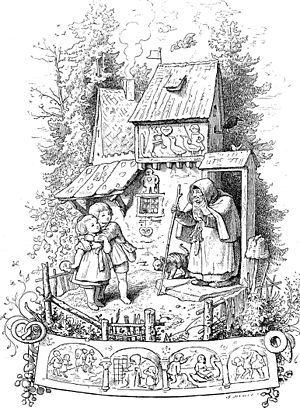Hansel and Gretel facts for kids

"Hansel and Gretel" (German: Hänsel und Grethel) is a fairy tale from Germany. The Brothers Grimm heard it from Dortchen Wild in Cassel and published it in their Children's and Household Tales in 1812. The Grimms revised the tale over the years. They gave the children names, changed the mother to a stepmother, and introduced Christian motifs. Their final version is dated 1857. The tale has been adapted to many media, most notably the opera Hänsel und Gretel (1893) by Engelbert Humperdinck. A stop-motion animated movie based on the opera was made in the 1950s.
Plot
In medieval Germany, Hansel and Gretel are the young children of a poor woodcutter. When a famine settles over the land, the woodcutter's second wife tells the woodcutter to take the children into the woods and leave them there to fend for themselves, so that she and her husband do not starve to death. The woodcutter opposes the plan, but his wife claims that maybe a stranger will take the children in and provide for them, which the woodcutter and she simply cannot do. With the scheme seemingly justified, the woodcutter reluctantly is forced to submit to it. They are unaware that in the children's bedroom, Hansel and Gretel have overheard them. After the parents have gone to bed, Hansel sneaks out of the house and gathers as many white pebbles as he can, then returns to his room, reassuring Gretel that God will not forsake them.
The next day, the family walk deep into the woods and Hansel lays a trail of white pebbles. After their parents abandon them, the children wait for the moon to rise and then follow the pebbles back home. They return home safely, much to their stepmother's rage. Once again, provisions become scarce and the stepmother angrily orders her husband to take the children further into the woods and leave them there. Hansel and Gretel attempt to gather more pebbles, but find the front door locked.
The following morning, the family treks into the woods. Hansel takes a slice of bread and leaves a trail of bread crumbs for them to follow to return back home. However, after they are once again abandoned, they find that the birds have eaten the crumbs and they are lost in the woods. After days of wandering, they follow a dove to a clearing in the woods, and discover a gingerbread house. Hungry and tired, the children begin to eat the house, when the door opens and the elderly woman that lives there emerges and lures the children inside with the promise of soft beds and delicious food. They enter without realizing that their hostess is a witch who built the gingerbread house to waylay children to cook and eat them.
The next morning, the witch locks Hansel in an iron cage in the garden and forces Gretel into becoming a slave. The witch feeds Hansel regularly to fatten him up, but serves Gretel nothing but crab shells. The witch then tries to touch Hansel's finger to see how fat he has become, but Hansel cleverly offers a thin bone he found in the cage. As the witch's eyes are too weak to notice the deception, she is fooled into thinking Hansel is still too thin to eat. After weeks of this, the witch grows impatient and decides to eat Hansel anyway.
She prepares the oven for Hansel, but decides she is hungry enough to eat Gretel, too. She coaxes Gretel to the open oven and asks her to lean over in front of it to see if the fire is hot enough. Gretel, sensing the witch's intent, pretends she does not understand what the witch means. Infuriated, the witch demonstrates, and Gretel instantly shoves her into the hot oven, slams and bolts the door shut, killing the witch. Gretel frees Hansel from the cage and the pair discover a vase full of treasure, including precious stones. Putting the jewels into their clothing, the children set off for home. A white duck (swan in some versions) ferries them across an expanse of water, and at home they find only their father; his wife having died from an unknown cause. Their father had spent all his days lamenting the loss of his children, and is delighted to see them safe and sound. With the witch's wealth, they all live happily ever after.
Images for kids
See also
 In Spanish: Hansel y Gretel para niños
In Spanish: Hansel y Gretel para niños




